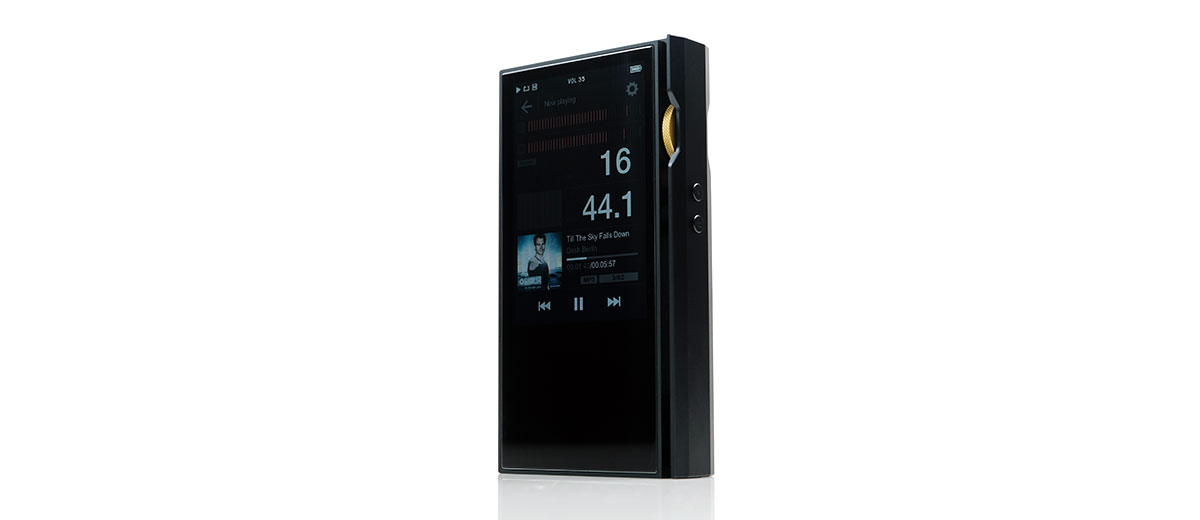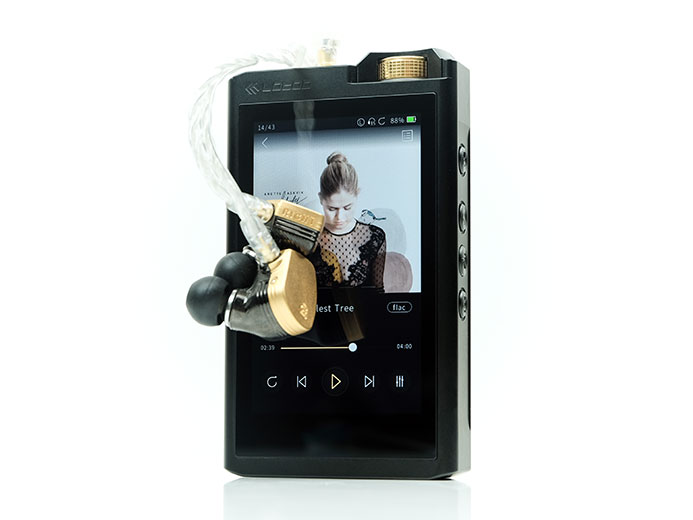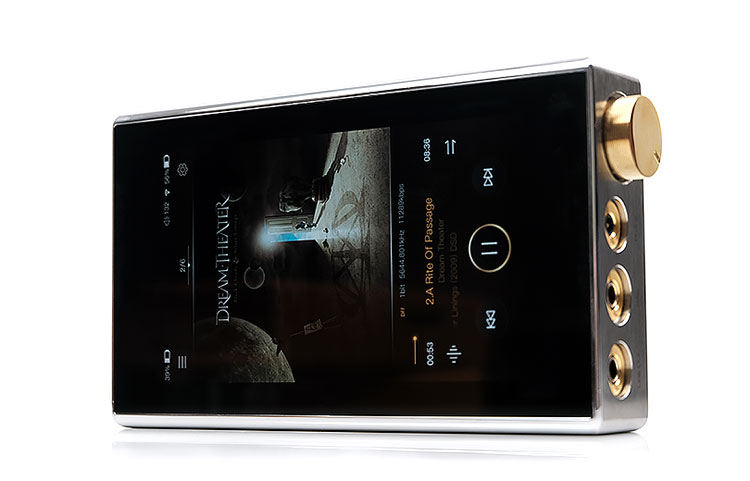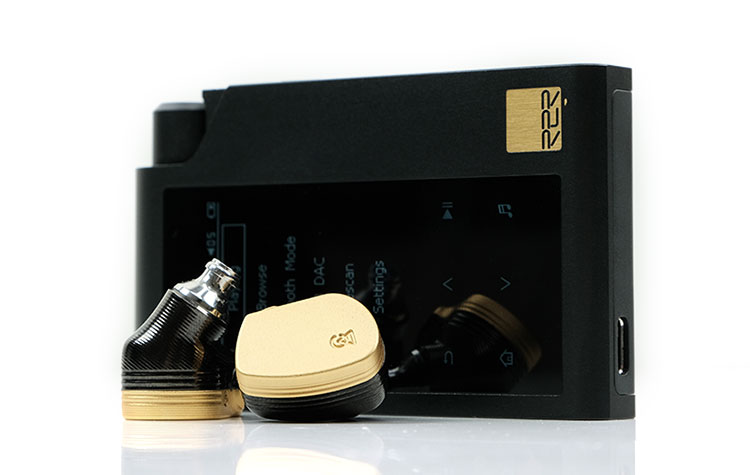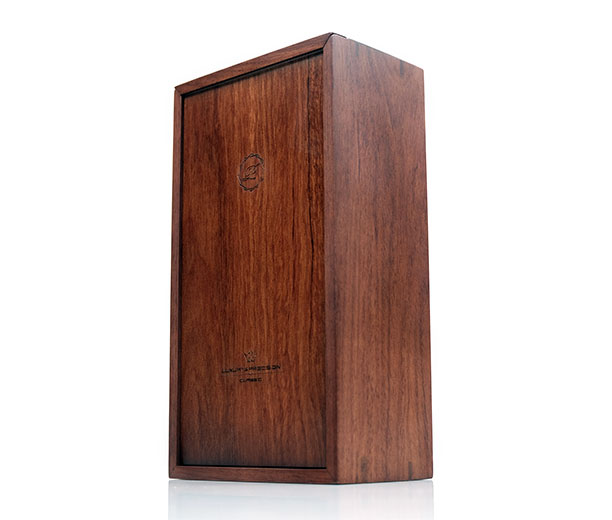Select Comparisons
All comparisons were done with two test monitors, the JH Audio Jolene, (custom format) and the Andromeda 2020 with the Leonidas Octa cable).
Lotoo PAW Gold Touch
$3199
We have compared the Touch before to the P6 but with the slightly different presentation and improve interface it is worth a revisit. This is still Lotoo’s flagship player which is testimony its longevity and TOTL performance.
Technical
The Touch uses a delta-sigma AK4497EQ DAC implementation which seems a little dated compared to recent DAP launches with dual-channel or AK4499EQ flagship chipsets. However, Lotoo future-proofed it quite well with top-tier decoding limits up to DSD512 and PCM 32BIT/768kHz.
They were also quite crafty in the implementation by splitting a lot of the task management into 3 distinct processes for wireless, the digital sub-system, and the audio signal. The touch also has an additional AK4137EQ digital sample rate converter (SRC) chipset for upscaling should you need it.
The P6 Pro takes a very different route with the 1/10000 resistor matched R2R rail so avoiding the use of chipsets altogether. It does use an FPGA for clocking control and BT protocol stack management so not everything is purely electrical. It does have one chipset, the MCU which is fairly lightweight for the OS and environmental controls.
Its decoding ceiling is a little lower than the Touch at DSD256 and PCM 32BIT/386kHZ. However, in terms of SNR, the SE of the P6 Pro has a 2dB advantage and the gap going balanced is very close at 125dB compared to the Touch at 127dB.
Both offer very black backgrounds and a hiss free experience with the P6 Pro able to offer a higher output rating going balanced at up to 700mW into a 32Ω compared to 500mW from the Touch.
The Touch is unique in that it doesn’t differentiate the power level for SE so at 500mW into a 32Ω it can offer more power compared to the P6 Pro’s 330mW rating from the same load.
Design
Both DAPs have a boxy but still fairly modern design with clean lines and well-protected dials. Neither have a form factor that is too big to operate with one hand. Still, the major difference between these two is the weight with the Lotoo weighing in at 311g compared to 248g for the P6 Pro.
The touchscreen of the P6 Pro does reduce the useability gap between it and the Touch immensely. I still would rate the bigger screen of the Lotoo a bit more user-friendly for touch useability and also a little easier on the eye with its more stylish OS.
Both have external memory slots though the Lotoo is well behind with no onboard memory and an insistence on using full SD-sized cards. The two DAPs also use USB-C for charging, data transfer, and USB-DAC functionality though the P6 lacks OTG.
Software
The P6 Pro has the same OS as the P6 but with added touch control. That means it’s an equally fast proprietary OS but with a slightly slower boot time compared to the Touch.
Even with touch, however, the P6 Pro OS is relatively linear compared to the Lotoo alternative. Navigation is far less linear or restrictive on the Touch and you do get some features that I would have liked to have seen on the P6 Pro such as customizable EQ and PMEQ.
The P6 Pro is still feature-rich for filters, USB control, and LO/PO options, but they tend to be more background audio controls whereas the EQ is not as impressive or as involving.
The media library is more evolved on the Lotoo with better drill-down grouping and more ambitious artwork integration throughout. One added bonus is OTA firmware updates from a very limited WiFi service on the Lotoo but both can also be locally updated with small firmware files.
Performance
I did not think it was possible but the P6 Pro actually makes the Touch (All filters off) sound slightly compressed. When I did the previous comparison to the Touch using the P6, it was all about the timbral differences, and granted, there are a fair few here with our tested monitors.
That is not the first thing that you hear though when comparing the P6 Pro with the Touch. It’s the dynamic range this time around and the lift the P6 Pro has from the original that makes a huge difference when comparing with the Touch.
The phrase that keeps popping into my head is just how much more vivid sounding the P6 Pro is, from the stronger bass response from the JH Audio Jolene to the better headroom with the Andromeda 2020. Vocals have better solidity and their own space with an impeccable sense of timing and space that seems to make the Touch performance somewhat tame.
There is also that R2R timbre and we can’t escape the differences here because it shows up all over the P6 Pro’s instrument note texture. The Lotoo sounds perfect, perhaps too perfect by missing a little bit of gritty texture with a pristine neutral sound, especially with higher pitching female vocals.
The P6 Pro goes a shade more euphonic with that bigger low-end, not too much mind you, but enough to broaden that note texture out, tease out a lot more nuanced detail on the note edges, and give you a very life-life tonal quality.
iBasso DX220 MAX
$1888
Technical
The MAXwalked away with our 2020 Top Gear Award for best DAP and with good reason. It is quite a bit cheaper than the P6 Pro and a limited run but personally, I think it punches well above its weight with its audio performance.
DAC
Inside, the MAX pretty much resembles the original digital implementation from the DX220 DAP with a delta-sigma dual Sabre ES9028PRO configuration. These are still class-leading chipsets in 2021, with PCM 32BIT/384kHz and native DSD decoding up to DSD512 as well as MQA X4 in its locker.
The P6 Pro is hugely different in its 1/10,000 resistor-based R2R rail and underlying FPGA Master implementation. Decoding does drop to DSD256 and PCM 32BIT/386kHZ but does not rely on single-chip computational processing, preferring instead for a bit by bit transformation into analog. MQA is not a thing on the P6 Pro and probably never will be.
Amplification
The P6 Pro does use opamps for their amplification stage whereas iBasso went all out with their analog implementation with a separate huge power supply to the digital board, some premium caps, resistors, and a custom 4-wiper potentiometer. LP’s big focus beyond the DAC was that relay-based Lossless Matrix Volume Control System.
The one caveat I do have with the dual MAX power supply system is the constant balancing of the digital and analog battery life. The fact that the MAX uses a DC wall wart for the analog side doesn’t make it any easier compared to the P6 Pro’s USB-C setup.
In terms of output, the MAX does have a bit more PO grunt right down to 300Ω loads with a maximum balanced output of 1758mW into 32Ω which is more than double the 700mW P6 Pro maximum output into the same load.
The P6 Pro does match or better for SNR compared to the MAX with a 122dB rating going SE compared to 125dB on the P6 Pro, both are the same for balanced.
Design
One is a DAP, the other is a brick, a stylish brick with premium materials but a brick nevertheless. The P6 Pro, in case you are wondering, is not the brick, it is the MAX.
The iBasso DX220 MAX is more of a transportable media player with its huge form factor and 700g weight compared to just the P6 Pro at just 246g. It is almost a different class of use on that basis with the MAX more likely glued to the desktop and the P6 Pro in your pocket.
However, the MAX does look beautiful in terms of aesthetics with its 5″ IPS 1080p touch screen and that aged-look CNC stainless steel body complete with gold-plated accents on the knobs and jacks. The P6 Pro black finish and wooden rear are quite a contrast though it also uses gold accents on the dial and jack sockets.
The only big drawback of the DX200 MAX is the lack of physical buttons aside from the dual function power and LCD screen button to the rear. Everything else is touch only. Yes, you can have a touch-only navigation process on the P6 Pro but playback is still allowed via its left panel physical controls and you can switch to a purely physical operation also via the OS menu.
Software
Some definite pros and cons here between the expandable and connected Android 8 of the MAX and the simpler but faster proprietary touch-based interface of the P6 Pro. The MAX Android interface feels modern, app expandable, reasonably fast though throttled by a capped and old Rockchip CPU clock to manage battery life.
The MAX can also dual boot into a pure music player via its Mango OS with plenty of good features maintained. This is where it gets a bit closer to the P6 Pro OS experience, albeit with a more lavish layout and some killer features.
You cannot beat the iBasso Mango OS and player for its useable PMEQ feature. This is one of the best in the business and something I would love to see on the P6 Pro OS.
The P6 Pro OS is much faster, less likely to throttle, and also less buggy. It is far better for battery life with less variance due to draining apps. However, it is not expandable and has no WiFi connectivity but does offer BT5.0 and LDAC much like the MAX.
This OS has a nod to modernity with BT but otherwise is designed for pure music playback with more limited EQ features.
Performance
On initial impression, you are going to think the DX220 MAX does quite well against the P6 Pro. It has that same excellent vocal emphasis, a very expansive sound with an excellent black background. However, once you start going through the minutes you start picking up some critical differences.
For a start, the dynamic range on both are great though the P6 Pro for me edges it during busy passages with superior low-level layering and a more distinct bass attack and decay.
You hear the same note on the MAX but it doesn’t have the same textural quality or distinctiveness. Yes, the MAX is more neutral on the quantity level for bass but what is there is a bit more one-dimensional.
The neutrally travels up a bit also so the MAX sound comparatively more neutral in both note weight, textural girth, and staging positioning. Contextually more neutral rather than strictly neutral is a better term.
For example, vocal presence and percussion presence are slightly forward on the MAX but further forward on the P6 Pro. Yet, at the same time, the P6 Pro seems to have more space to deliver that vocal, giving the impression that the MAX is less distinct even though it really isn’t.
The weight is similarly biased so with something like the Jolene the vocals have more physicality and a stronger fundamental also from the enhanced low-end of the P6 Pro. There is something about R2R and dynamic driver texture that just gels so well together.
Overall, the MAX is more reference for me, typical of an excellent delta-sigma sound with a slight hint of warmth to keep it as natural as possible. The P6 Pro is the more vivid, the more physical also, teasing out more resolution in instrumental and vocal texture.
HIFIMAN R2R2000 BLACK
$2500
Technical
I want to be clear from the outset, though the R2R2000 has R2R in its name it is not the same implementation as the classic resistor-based rail implementation inside the P6 Pro. Instead, the R2R2000 uses a dual multibit 24-BIT Texas Instruments PCM1704K DAC chipset.
In fact, the LP has been very keen to point out their improved discreet R2R implementation inside the P6 Pro is equivalent to 16 PCM1704k chipsets so that is quite a difference between the two players. I think those claims do seem substantiated when you compare those SNR numbers with the R2R2000 a full 10dB lower at 115dB @ +/-3dB compared to the 125dB from the P6 Pro.
Also, there is a significant gap in the decoding capability of the two players with the P6Pro capable of up to 32BIT/384kHz PCM and DSD256 compared to the R2R2000’s lower 24bit/384kHz PCM and DSD64.
The P6 Pro also does better in terms of output power at 700mW into a 32Ω load compared to the R2R2000’s 500mW into the same load. However, the R2R2000 offers a higher output rating for single-ended at 320mW compared to 180mW into the same rated load.
Mind you, the R2R2000 noise floor is just so much higher, especially for sensitive IEMs whereas the P6 Pro has a beautiful black background for similar monitors such as the Andromeda.
Bluetooth is available on both, in fact, that is the main thrust of the R2R2000 so both offer LDAC receiving though the R2R2000 can only offer BT4.2 compared to BT5.0 on the P6 Pro.
Design
The R2R2000 is tiny, very pocketable with a very ergonomic shape, certainly much smaller than the P6 Pro. The P6 Pro is a more traditional box shape, thicker but beautifully designed. The P6 Pro’s aesthetics are more useful though with the bigger more legible color screen but there is no denying the handling comfort of the very light (142g) R2R2000 form factor.
Both offer microSD external memory but the P6 Pro goes further with 64GB onboard memory whereas the R2R2000 has none. The two devices also have USB-C ports with USB-DAC, charging capability though no direct data transfer for the R2R2000. The R2R2000 does offer OTG digital audio via its USB-C which the P6 Pro does not do.
Both have memory limits, however, though the P6 is double at 12k and the R2R2000 at around 6k tracks.
The P6 Pro battery life is just so much better at close to 15 hours consistently. The R2R2000’s does really well with the eco mode offering well above 20 hours on a normal cycle but you lose a lot of functionality and it drops to just a few hours of use in HiFi Mode and all functions turned on.
Software
The R2R2000 offers a capacitive section below the display part of its tiny LCD screen which gives it a sort of faux touch capability to allow you to navigate. The navigation speed felt competitive against the P6 non-touch controls but compared to the P6 Pro’s capacitive touch panel it feels like a pretty turgid affair.
The Pr Pro’s larger screen and snappy OS response are much easier to use than the tinier R2R2000 black and white jittery screen. You could be scrolling for a lot longer on the R2R2000, see no artwork, click back and forth to find the required features. It feels incomplete as an OS with a UI that is confusing.
The P6 Pro also has a lot more options to control from the OS such as DSD and PCM filters, EQ, and USB connectivity modes. It also has a metatag media library with artwork and playlist management whereas the R2R2000 is pure folder navigation.
Performance
Whilst much of what I said about the P6 versus the R2R2000 Black timbral differences remain true for the P6 Pro, it’s not the first thing that really stood out for me this time around.
This time around was all about the midrange and this taps into how I described the R2R2000 Black as teasing out a slightly v-shaped tuning. That is definitely the case here, especially with the Jolene which is a little more relaxed in the mids than the Andromeda.
With the P6 Pro, the mids are much clearer, more forward, and vivid sounding whereas the R2R2000 Black drops that a little in favor of more bass bloom. A lot of that is down to the dynamic range as well and you can hear a palatable difference between the two presentations, more so given the R2R2000’s little dip in the Jolene mids.
I can’t say this time either that the R2R2000 has the more extended treble either. The P6 Pro treble is much better resolution and presence though by no means bright but rather it just sounds very balanced with the Jolene. The R2R2000 has excellent extension but it is not as vibrant and doesn’t quite balance out the bloom on the low-end.
All of this impacts staging which feels more complete with the P6 Pro’s stronger instrumental separation through the mids. You get excellent depth and extension on the R2R2000 Black but its dynamic range does not tease out as much 3-dimensional space in comparison.
Our Verdict
As a pure music player or for quality audio in a compact portable form factor, nothing can come close to the performance of the P6 Pro. It takes everything magical and wonderful about the R2R sound of the P6 and injects greater urgency, a slightly more accurate harmonic balance, and a big upgrade in dynamics.
Unless you are a complete treble head or prefer that mellower laid-back ambiance of the original P6 I cannot fail to see how the P6 Pro sound quality could not seriously impress even the most hardened or thrifty of audiophiles.
Caveats? The OS is still very simple and whilst the BT stack is improved and the touchscreen makes a huge difference in its UI the connectivity is much the same. This is not a DAP for the smartphone generation who want audio players to come with expandability and virtual interaction. You still will have to use the BT to stream which is never ideal.
Otherwise, Luxury and Precision have a beautifully constructed portable platform to play some truly world-class sounding audio.
P6 Pro Specifications
- Discrete R-2R Array DAC.
- Equivalent to using 16 PCM 1704 chips.
- Ultimate audio experience with a high signal-to-noise ratio of 125dB.
- Refined amplification circuit for distortion-free output.
- Further optimized Luxury & Precision Lossless Matrix Volume Control System(LLMVS).
- Accurate FPGA clock.
- High-quality Bluetooth audio algorithm.

